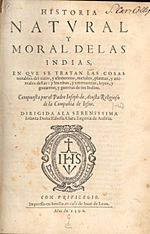José de Acosta facts for kids
José de Acosta (born in 1539 or 1540 in Medina del Campo, Spain – died February 15, 1600 in Salamanca, Spain) was a Spanish Jesuit missionary and naturalist. He lived in Latin America during the 1500s.
Acosta was one of the first to describe altitude sickness. He noticed people felt sick when crossing the high Andes mountains in 1570. He thought the air was too thin for humans. This type of altitude sickness is sometimes called Acosta's disease.
Contents
Life and Travels
José de Acosta was born in Medina del Campo, Spain. His family had five sons, and four of them, including José, joined the Society of Jesus (Jesuits). José became a Jesuit at age 13 in 1553. Before leaving Spain, he taught theology.
In April 1569, he was chosen to go to Lima, Peru. The Jesuits had just started their work there.
Journey to Panama
In 1570, when he was 32, Acosta left Spain with other Jesuits. They first landed in Cartagena de Indias and then Nombre de Dios. From there, they traveled about 62 miles (100 km) through a tropical forest.
He was amazed by the beautiful scenery and new sights. He even saw clever monkeys playing tricks. From Panama, he sailed to Peru to continue his missionary work. He expected the equator to be very hot, but he found it cool in March. This made him laugh at old ideas about the world.
Life in Peru and Altitude Sickness
When Acosta arrived in Lima, he was asked to cross the Andes mountains. He traveled with about 15 companions. They went through the high pass of Pariacaca, which is over 14,000 feet (4,267 meters) high. Everyone in the group felt very sick from the thin air.
Acosta described these feelings, which happened to him three more times when crossing the mountains. He was one of the first people to write in detail about altitude sickness. He explained it was because the "air... is so thin and delicate that it is not proportioned to human breathing." This condition is now sometimes called Acosta's disease. He also wrote about getting snow blindness and how an Indigenous woman helped him.
Acosta arrived in Peru two years after Don Francisco de Toledo became the Viceroy (a ruler representing the king). Acosta helped the Viceroy in his work to organize the country. He also joined the Viceroy on a trip to Charcas.
The main Jesuit center in Peru was in Juli, near Lake Titicaca. Here, a college was started, and the Jesuits learned the local languages. They even set up a printing press. Acosta likely lived in Juli for much of his time in Peru. He probably saw the famous comet of 1577 from Juli. He also spent a lot of time writing important books there.
Later, Acosta moved to Lima. He helped supervise the making of a large bell. He also taught theology at the University of St. Mark in Lima. He was known as a great speaker. In 1576, he was chosen to be the provincial, a leader of the Jesuits in the region.
Acosta helped start several colleges, including those in Arequipa, Potosí, Chuquisaca, Panama, and La Paz. He traveled widely for his duties, learning a lot about the vast region and its native people. He also played a very important role in the Third Council of Lima in 1582, which was a meeting about the church.
Journey to Mexico
After the Third Council of Lima, Acosta sailed to Mexico with all his writings. He had spent 15 years working on them. During his journey, he observed nature carefully. He learned from a Portuguese pilot about places where a magnetic compass did not change direction.
Acosta landed in Huatulco and then traveled by land to Mexico City. He lived there in 1586. He used this time to gather information about the Aztec people's culture and religion. He also learned about the natural resources of the country.
Return to Spain
In 1585, the King called Acosta back to Spain. He sailed home in 1587. His ship carried a lot of valuable cargo, including gold, silver, emeralds, and other goods like ginger and animal hides.
In Spain, he continued his important work. He taught theology in Rome in 1594 and became the head of the Jesuit College at Valladolid. At the time of his death at age 60, he was the rector (head) of the college in Salamanca.
Works and Ideas
José de Acosta is best known for his book, Historia natural y moral de las Indias (Natural and Moral History of the Indies). This book was published in Seville in 1590 and was quickly translated into many languages.
This book was one of the first detailed and realistic descriptions of the New World (the Americas). Acosta wrote about the natural world and the history of the Americas. He discussed topics like winds, tides, lakes, rivers, plants, animals, and minerals.
More than a century before others, Acosta suggested that the native people of Latin America had come from Asia. He thought they might have crossed a land bridge, which is now known as the Bering Strait. He also described the customs and history of the Inca and Aztec people.
See also
- Viceroyalty of Peru
- List of Jesuit scientists
- List of Roman Catholic scientist-clerics
- In Spanish: José de Acosta para niños



